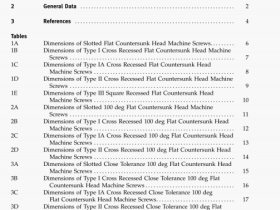ASME B89.1.13-2001 pdf download

ASME B89.1.13-2001 pdf download.MICROMETERS.
Al GENERAL
This Appendix is intended to provide gcneiai guidance on good operating procedures involving ,iucrometen, spreifically the outside. inside, and depth microrn
eICTS
A2 MICROMETER, OUTSIDE
A2.1 Zero Setting. Mechanical Micrometer
Prior to talung measurements, the zero point of the micrometer must be established Zero selttng is the first step of operation with outside, inside, or depth micrometers. Clean the anvil and spindle measuring faces (I in. or 25 mm range micrometers) by tnserting lint-free paper between them and lightly closing the spindle, then slowly pulling the paper througfr A lintfree cloth can be used to clean the spindle and anvil measuring faces on larger micrometers. Observe graduations and make sure the micrometer reads zero with clean measuring faces. II the micrometer does not read zero, adjust the sleeve accordingly.
A22 Zero Setting. DigItal Micrometer
For a digital micrometer equipped with a zero-setting button, clean the faces, then close the micrometer using the friction or ratchet stop. Press the reset or zero button. I! ABS (Absolute) or INC (Incremental) zero is featured, press ABS zero.
A2.3 Zero Setting, Large Micrometers
Micrometers larger than the 0—I in. (0-25 mm) range models must hr art to zero by using a setting standard or gage block. Use friction or ratchet stop whenever possible. When setting zero on micrometers larger than 12 in. (300 mm), the micrometer should be held in the position of its intended use (horizontal or vertical).
A2.4 Friction or Ratchet Stop
Friction o ratchet stops on micrometers provide a unifonn force when making measurements. The accuiacy and repeatability is generally better when using friction or ratchet stops.
*2.5 Micromet.r Stand
While one-hand operation is a common practice, the use of the micrometer stand s recommended when mare accurate Ineaufements are required. It allows the operator to free both hands and generally lowers the uncenamey of the measurements.
A2.6 How to Read the Micrometer
*2.6.1 Micrometer, Outside, Inch. 0.001 In. Resolution. Graduations are engraved on the adjustable sleeve and graduated thimble of a micrometer. The adjustable sleeve is graduated in 40 equal puts with each line representing 0.025 in., which corresponds to one thread of the micrometer spindIe The numbers on the adjustable sleeve, I, 2, and 3, represent 0100 in.. 0.200 in.. and 0.300 in., respectively. The graduated thimble has 25 lines on its circumference, each line representing 0.001 in. The numbers on the graduated thimble, I, 2. 3. and 5, represent 0.001 in., 0.002 in, 0.003 in,, and 0.005 in., respectively.
*2.6.2 M.crom.t.r, Outside, Metric. 0.01-mm Reading. Graduations are engraved on the adjustable sleeve and graduated thimble of a micrometer. The adjustable sleeve is graduated in 50 equal parts, with each line represeitting 0.5 mm, which corresponds to one thread of the micrometer spindle. The numbers on the adjustable sleeve, 5, 10, 15. represent 5 mm. 10 mm. and 15 mm. respectively. The graduated thimble has 50 lines on its circumference, with each line representing 0.01 mm, The numbers on the graduated thimble. 5, 10. 15, and 30. represent 0.05 nuts, 0.10 mm, 0.15 mm, and 0.30 mm, respectively.
*3 MICROMETER. INSIDE
In using Ibe inside micrometer to, measure holes, one anvil should be kept Litionar/aád the other anvil should be moved back and toqth, and up and down, while the miaomeler ii being expanded until it no longer moves freely. h is good practice to take at least three readings to ensure that the diameter has been measured correctly.
A3.2 M.asunng Large Pieces
When large objects ace measured in the hotizoctal position using two-pcñt contact, support the internal micrometer with .ee blocks or other means of support to reduce bending. It is preferable to avoid using additional operators as this increases the transfer at heat from the operator to the gage.









